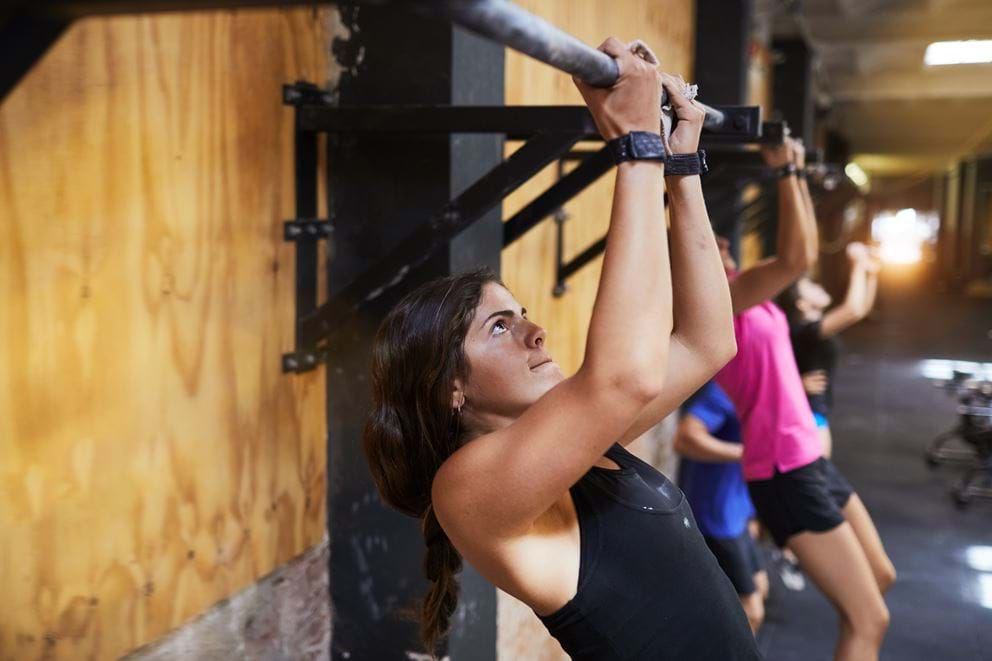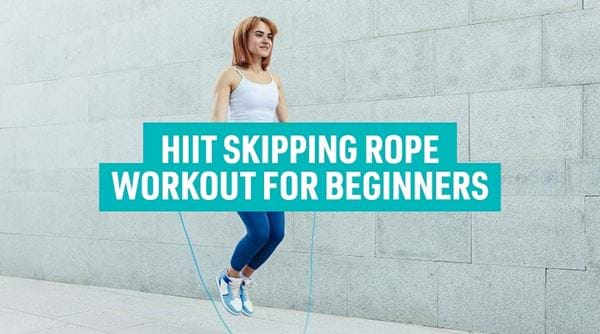Pull Ups For Beginners

How Long To Get First Pull Up | Is It Harder For Women | Exercises To Do | How Many Reps And Sets
Are you looking to master one of the most challenging bodyweight exercises in the gym? The pull up is an advanced pulling exercise which involves some serious back and bicep strength, as well as a strong core. Multiple muscles are recruited, including the latissimus dorsi, trapezius, rhomboids, biceps, deltoids, and core.
Mastering the pull up is a real test of strength, with benefits including improvements in pulling strength, muscle growth, posture, and stability. Getting the pull up takes time and commitment, but if you’re serious about getting this move under your belt, you’re in the right place. We’ve pulled together a beginner’s guide to pull ups to help you get your first pull up.
There are many grips that can be used for pull ups and chin ups, but we are looking at the wide grip, pronated pull up technique. This is arguably the most challenging pull up variation and mastering this version should mean you can do the other grips easily.
How Long Will It Take To Get Your First Pull Up?
It’s difficult to provide a timescale of when you should achieve your first pull up as there are many factors involved – your body weight, core strength and upper body strength will all have an impact on how long it takes to get your first pull up. If you’re heavier, it’ll take you longer to pull your own weight and similarly if you have little muscle mass your first pull up won’t come over night!
As a guide, if you already strength training, consider 6 – 12 weeks as a suitable timescale to build your strength and achieve your first pull up. If you're new to exercising or lifting weights, it might take longer. If you’re not noticing progress or still can’t perform the exercise after 12 weeks, it’s likely you’re not training hard enough! Ensure to apply progressive overload to your upper body lifts every week and try to train within 3 reps of muscular failure to enhance your strength gains!
Is Getting Your First Pull Up Harder For Women?
Achieving your first pull up is a challenging feat for anybody, even those who are well trained will likely admit that pull ups are amongst the most difficult of exercises. The movement requires practice and consistency for both men and women, but generally speaking men will find it easier to get their first pull up than women. This is due to their higher levels of testosterone and therefore greater levels of muscle mass, plus an improved ability to build strength and muscle.
That said, this isn’t a fixed rule and there are many women who find it easy to gain their first pull up and beyond, and many men who struggle.
How To Get Your First Pull Up As A Beginner
If you can’t do a single pull up, it can be difficult to know how to even get started. Building your back and bicep strength is the best way to train pull ups as a beginner, as it allows you to build the strength needed to pull your own bodyweight.
Here are six exercises that will help you to get your first pull up. Incorporate a few of these into your current workout routine, or pair them together to create a beginner pull up programme.
-
Lat pulldowns
The lat pulldown machine closely replicates the pull up and targets many of the same muscle groups, including the latissimus dorsi, posterior deltoids, rhomboids, trapezius, and biceps. Rather than pulling your body upwards towards the bar as you would during a pull up, you take a seated position and pull the bar towards your body, which provides greater stability, making this exercise easier.
While there are differences between the lat pulldown and pull up, this exercise helps to strengthen these muscles in the same movement pattern that is needed for the pull up.
- Take a seat and adjust the pad to sit tightly against your thighs. Ensuring you’re secure in the seat helps to keep the movement controlled, which minimises the opportunity to swing the bar down using unintended muscle groups.
- Next, stand up to hold the bar just outside of shoulder width using a pronated grip, so that your palms are facing away from you.
- Sit down, with your feet planted on the floor and allow your arms to extend.
- Start the reps by pulling the bar towards your sternum. Think about pulling your elbows into your back pockets and pull the bar down to just below your chin.
- Reverse the rep back to the starting position by ensuring you have full control of the bar by slowly allowing your arms to extend.
Top tip: To make this exercise more challenging, you can really slow down the eccentric portion of the movement. The eccentric phase of an exercise is when the muscles lengthen. Just perform the first part of the exercise as normal, and then when reversing to the start position count to three seconds to ensure you’re really challenging the muscle groups.
-
Assisted pull ups
The assisted pull up machine allows you to replicate the pull up by using weight to counterbalance your bodyweight so that you are pulling less weight. To use the machine, you adopt a kneeling stance which reduces involvement from the core, so it is not a like for like representation of the pull up. However, it is a great way to become familiar with the pull up movement and build strength.
Unlike most gym machines, the more weight you choose, the easier this exercise is. If you were 70kg and you selected 70kg, you’d effectively be moving no weight, but if you chose 35kg, you’d be pulling 35kg. Make sure to choose a weight that allows you to complete your reps with good form.
- Select a load that will provide sufficient assistance to your pull up.
- Grip the bar using a wide, pronated position that’s just outside of shoulder width apart.
- Kneel on the assistance pad, so that your bodyweight pushes it downwards and your arms can fully extend.
- Commence the reps by pulling yourself towards the bar, thinking about pulling your elbows down and behind you, towards your back pockets.
- Pull yourself upwards until your chin is just above the bar.
- Reverse the movement by slowly extending your arms until you have returned to the starting position.
-
Straight arm hangs
When learning how to do pull ups, people often focus on the pulling aspect but overlook the grip strength and core stability involved. Straight arm hangs trains the grip and core, and mastering this exercise can help to keep your body stable when hanging from the bar. This means less swinging during a pull up which saves energy and improves your pull up form.
- Use a platform or box that you can stand on to grip the bar using pronated grip, just outside of shoulder width apart.
- Hang from the bar so that your arms are extended.
- To engage your core muscles, squeeze your abs by pulling your belly button towards your sternum, allowing your feet to come marginally in front of the body to create a hollow body position.
- Ensure stability by retracting your shoulder blades and pulling them together to allow your chest to lift slightly towards the bar.
- Hang from the bar for as long as you can before taking a rest and performing the exercise again.
Top tip: If you find your lower body is swinging and you’re unable to remain still, it may help to cross your legs near your ankles! Mastered the straight-arm hang and looking for a challenge? Why not record the amount of time that you manage to hang from the bar and try to beat this each week.
-
Single arm dumbbell rows
While the pull up requires the performer to pull in a vertical direction, it is important to incorporate exercises that require a horizontal pull too. This will ensure all of the muscle groups in the back are strengthened, which enhances overall upper body strength and prevents muscular imbalances.
Unilateral exercises like the single arm dumbbell row also prevents muscular imbalances between the two side. In bilateral exercises, the strong side can take over which can increase the strength gap between the two sides and limit overall strength gains. Working each side on its own stops this from happening. We recommend starting on your weaker side when performing unilateral movements so that you only do as many reps as your weaker side can do.
- Set up the exercise by holding one dumbbell in the hand of your working side. Lean over a bench with the opposing leg and hand resting on the bench. Ensure that the foot on your working side is planted firmly on the ground to give you a stable position.
- Allow your working arm to extend, remembering to keep your spine as straight as you can, this is known as maintaining a neutral spine.
- Commence the reps by rowing the dumbbell towards your hip, thinking about rowing your elbow in an arc direction rather than straight upwards towards the ceiling.
- Slowly return the dumbbell to the starting position in a controlled manner.
- Once you’ve completed your reps, swap over your set up to train the other side!
Top tip: It’s important to remain controlled during the single arm dumbbell row to ensure the weight is not being lifted by other joints or muscle groups. As this is a free weight exercise, your body will need to remain more stable to prevent the torso from swinging. If you find you’re unable to maintain the correct form and positioning we’d advise opting for a lighter dumbbell.
-
Eccentric pull ups
Practicing the eccentric portion (when the muscles begin to lengthen) of an exercise is an effective way to expose the body to loads it cannot handle during the concentric portion (when the muscles are shortening) of the movement. Eccentric exercises are great for building strength and helping the body become accustomed to the load.
In the pull up, the eccentric phase is when the arms begin to extend to return to a hang. Eccentric pull ups are often called negative pull ups.
- To perform the eccentric, pull up, you’ll need to use a platform or box to stand on that allows you to easily reach the bars.
- Take a pronated grip, just outside of shoulder width and ensure your chin is just above the bar before commencing. You may need to jump up a little from the platform you are standing on to reach the starting position.
- Once you feel stable in the starting position, lower your body as slowly as you can by extending your arms. The slower you can perform this movement, the more challenging it is going to be.
- Once your arms are fully extended stand back on the box and revert to the starting position before repeating the movement again.
-
Alternating dumbbell bicep curls
While the back muscles are the major players in the pull up, the biceps also help to assist this movement and training the biceps can help you to master your first pull up. Most back exercises will work the biceps to some degree but doing isolation exercises exposes these muscles to more volume, increasing strength more effectively – which will help with pull ups and other back exercises.
Alternating bicep curls allow you to train the biceps unilaterally by alternating the reps which can help you to focus on any imbalances between your arms. Remember to start your reps on your weaker side first!
- Begin by holding a dumbbell in each hand using an underhand grip so that your palms are facing away from you, this is known as a supinated grip.
- Allow your arms to extend so that the dumbbells are positioned either side of your thighs.
- Commence the reps by flexing at the elbow, keeping it pinned to your side as you squeeze your bicep to curl the dumbbell towards the corresponding shoulder. Focus on squeezing and contracting the bicep in this top position.
- Remain controlled when reversing the movement, extending your arm to the starting position.
- Next, complete the movement again with your other arm.

How Many Reps And Sets Should I Be Doing To Achieve My First Pull Up?
There is no one perfect range of reps and sets for achieving your first pull up – the most important element of gaining strength is training your muscles close to failure, so that the final two reps of each set are a challenge.
Lifting heavy weights for low reps (3-5) is best for strength, moderate reps (6-12) are best for hypertrophy, and high reps (12+) is best for endurance. Generally, using a combination of rep ranges is best for muscle mass and strength. As strength is the most important factor for pull ups, prioritising lower and moderate rep ranges (3-8) will likely build your strength up quicker.
For lower reps, it’s recommended to complete 4-5 sets in order to achieve a sufficient level of volume to aid strength and muscle growth. For moderate rep ranges, go for 3-4 sets, and aim for 2-3 sets for higher rep ranges.
If you are consistently training these exercises and progressively overloading on your lifts, you’ll be well on your way to doing your first pull up! Remember, this is a challenging exercise that takes a lot of practice and effort so don’t feel disheartened if it takes some time. Monitor your progression with these exercises to stay motivated.
Need tailored advice to achieving your fitness goals? A Personal Trainer can provide one on one advice and a build a bespoke programme to get you there quicker. Check out our blog for more fitness advice here.


